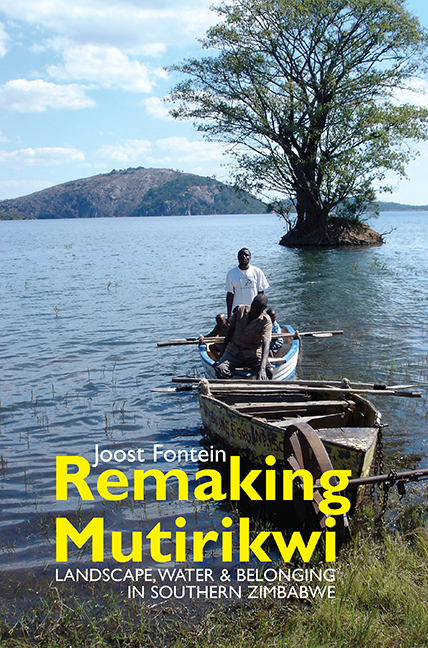Book contents
- Frontmatter
- Dedication
- Contents
- Illustrations
- Acknowledgements
- Note on Fieldwork, Notes & Sources
- Glossary
- Acronyms & Abbreviations
- Chronology
- Remaking Mutirikwi: An Introduction
- Part One Remaking Mutirikwi in the 2000s
- Part Two Damming Mutirikwi 1940s–1990s
- Epilogue: Remaking Mutirikwi in the late 2000s & early 2010s
- Bibliography
- Index
- Eastern African Studies
Epilogue: Remaking Mutirikwi in the late 2000s & early 2010s
Published online by Cambridge University Press: 11 June 2021
- Frontmatter
- Dedication
- Contents
- Illustrations
- Acknowledgements
- Note on Fieldwork, Notes & Sources
- Glossary
- Acronyms & Abbreviations
- Chronology
- Remaking Mutirikwi: An Introduction
- Part One Remaking Mutirikwi in the 2000s
- Part Two Damming Mutirikwi 1940s–1990s
- Epilogue: Remaking Mutirikwi in the late 2000s & early 2010s
- Bibliography
- Index
- Eastern African Studies
Summary
Given all the disappointed returns and frustrated futures around Mutirikwi in the 1980s, it is hardly surprising that the land invasions of 2000 began in Masvingo, soon after the constitutional referendum of February that year (Sadomba 2011:170; Alexander 2006:186). Commentators within and without Zimbabwe quickly identified this as a critical moment, marking a rupture in Zimbabwe's postcolonial history. While others argued the ‘war veteran-led land revolution’ had begun in Svosve in 1998 (Sadomba 2011:119–49), the stories recounted in this book suggest that much longer and more complex histories and historiographies are at play. The ongoing remaking of Mutirikwi's landscapes, traced here, points to the active and affective co-existence of many pasts and futures, and of past futures and future pasts, immanent and emergent in the materialities of milieu. It suggests that rupture, change and difference cannot be properly understood or even identified, except relationally, in the context of the material, imaginative and discursive endurances and continuities with which they are in tension, through which they gain traction, make sense, and can be made sense of. This offers a challenge not only to those who might identify the land occupations of 2000 as a decisive, and divisive, break in Zimbabwe's history, but more broadly to the temporal (pre-colonial, colonial and postcolonial) schemas through which Africanist scholars have conventionally ordered African pasts and divided labour amongst themselves.
For many aspiring to return to the graves and ruins of forefathers and past lives forged in the substance and form of Mutirikwi's landscapes, the colonial period can appear as just a blip in longer continuities of belonging that neither the grandiosity of the dam nor the white imagined futures it afforded (or that afforded it) could deny. But this blip did not come to an end with independence in 1980, despite the euphoria of that moment, and the aspirations of return that nationalism and war had promised. The re-Africanisation of Mutirikwi's Europeanised landscapes had to wait. If, for some, 2000 witnessed a rupture marking the ‘plunging’, ‘exhaustion’ of developmental nationalism (Bond & Manyanya 2003; Campbell 2003), or a ‘retreat from’ or ‘end of’ modernity in favour of authoritarian nationalism (cf. Worby 2003), for many around Mutirikwi the rupture of 2000 marked a return to the aspirations of the 1970s and early 1980s, and to the delayed promises of independence.
- Type
- Chapter
- Information
- Remaking MutirikwiLandscape, Water & Belonging in Southern Zimbabwe, pp. 288 - 309Publisher: Boydell & BrewerPrint publication year: 2015

